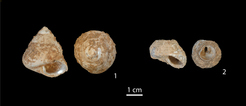Modern humans occupied the Near East 45,900 years ago and colonized Europe from there
A multinational team led by researchers from the Max Planck Institute for Evolutionary Anthropology (Leipzig, Germany), working in collaboration with colleagues from the Universities of Leiden, Groningen (the Netherlands), Mainz (Germany), York and Cambridge (UK), analysed shells recovered at Ksâr ‘Akil, a site in Lebanon. Ksâr ‘Akil is one of the few sites in the Near East where modern human fossils are associated with Upper Palaeolithic (UP) tools. The authors radiocarbon-dated the shell carbonates of the mollusc species Phorcus turbinatus that was eaten by prehistoric humans. Using several independent lines of evidence in a novel approach, they could show that modern humans carrying a UP toolkit occupied the Levant at least 45,900 years ago. This confirms UP modern human presence in the Levant prior to their arrival in Europe and suggests that the Levant served as a corridor for the colonization of Europe by modern humans.
